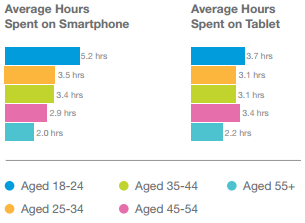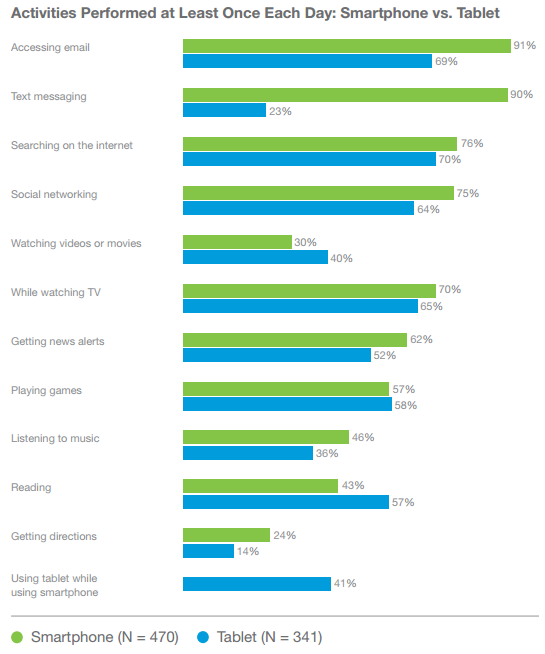Users: Mobile vs. Tablets
Interestingly, mobile can mean different things for different people. For marketers, mobile is a large category of non-computer technology, including smartphones, tablets, and e-readers. However, consumers tend to view mobile as a single device, which is usually their smartphone. 32% of participants also said they associate mobile with ease of use and on the go. With these facts considered, consumers truly have strong feelings tied with their personal mobile devices as a way to connect.

For reference, 265 participants were classified as smartphone owners while the remaining 205 owned both a smartphone and tablet. The graph to the right displays the average amount of hours spent on each device based on age groups. On average, consumers spent 3.3 hours a day on their smartphone. Although it’s no surprise consumers between the ages of 18-24 spent the most amount of hours on their smartphone, 55+ year olds were not too far from the average with 2 hours a day. When it came to tablet usage, overall hours spent decreased but were still at a daily average of 3.1.
As mentioned when discussing consumers’ opinions of mobile, tablets are seen as a complement to a smartphone, not a replacement. Typically, they are owned by 35+ year olds with $75-$100k in earnings who can afford the additional technology. For consumers who own smartphones and tablets, the time spent on smartphones isn’t decreased. Tablets are instead used as a companion device, usually at home, ultimately increasing overall time spent on technological devices. As seen among the 41% of survey takers who use their tablet and smartphone simultaneously at least once a day. Now you know who is utilizing these devices, but what are they being used for?
Consumer Activities: Mobile vs. Tablets
When comparing online site visitation, smartphones were most used during the hours of 8 AM to 6 PM and tablet usage somewhat increased after 6 PM. Below is a graph showing the different tracked activities performed by consumers at least once a day. For those using their smartphone, email (91%) and text messaging (90%) are the most performed activities daily. Tablets are also used for checking email daily by 69% of consumers, the second most performed action for this device. Searching the internet was popular among both devices. Specifically, 70% of consumers searched on their tablet and 76% on their smartphone. Social networking sites were also common activities on both with 75% of consumers accessing from their smartphone and 64% from their tablet.

Conclusions
Knowing who is accessing your content when and where is a huge step in the right direction. However, it’s only the beginning. In ExactTarget Marketing Cloud’s research, 91% of consumers rated the factor of accessing content any way they want as important. Furthermore, 87% of consumers who owned both a smartphone and tablet stated a seamless experience across all devices as important. So not only should your content be compelling but also the easiest to access across devices. With this in mind, below is a list of other considerations when moving forward with your mobile strategy.
Go Beyond Mobile
If you haven’t made your website mobile friendly yet, that should be the first step in your mobile strategy for 2014. Among our mobile survey respondents, nearly 74% of said they have a responsive website or plan to this year. However, mobile isn’t the only device you should optimize for. 54% of participants from the Mobile Behavior Report explained how sites that are optimized just for mobile devices don’t provide enough content. Ensure your content is accessible across all channels to make the most out of your information among consumers.
Optimize Specific Viewing Environments
Although similarities were present in activities performed on both smartphones and tablets, it’s unwise to assume all web related activities are similar across devices. Mobile web differs from mobile app content just as phones differ from tablets in consumer usage. Same goes for social media sites, with Facebook and Instagram peaking during the evening and Twitter active all day. Consider these differences when publishing social content in order to stay ahead.
Don’t Assume
It never hurts to provide assistance when using these new technologies. For example, 28% of surveyed consumers said they didn’t know how to access content through a QR code or a smartphone coupon, or didn’t have the mobile app. Additionally, one association from our Mobile Readiness Survey results stated their barrier to going mobile was they simply didn’t know what options were available. Helping your customers understand their mobile channels and how to engage through them is the best way to guarantee they are able to access it.
With these findings and suggestions, we hope you develop a mobile plan that works best for your organization.
To download the whitepaper, please visit exacttarget.com/2014-mobile-behavior-report.



